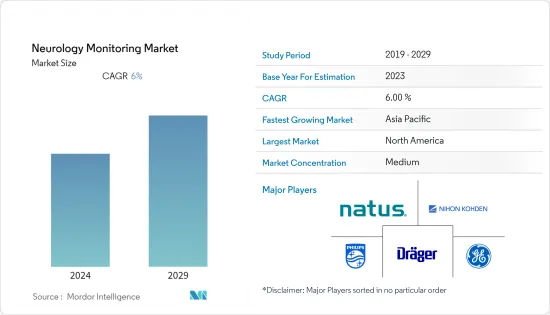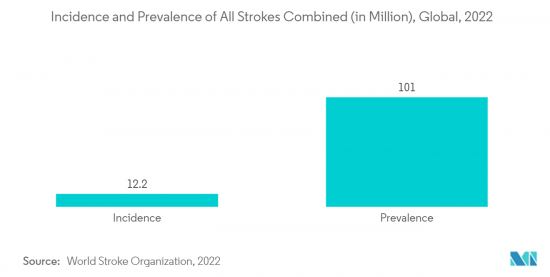 |
市場調査レポート
商品コード
1404112
神経モニタリング:市場シェア分析、産業動向と統計、2024~2029年の成長予測Neurology Monitoring - Market Share Analysis, Industry Trends & Statistics, Growth Forecasts 2024 - 2029 |
||||||
● お客様のご希望に応じて、既存データの加工や未掲載情報(例:国別セグメント)の追加などの対応が可能です。 詳細はお問い合わせください。
| 神経モニタリング:市場シェア分析、産業動向と統計、2024~2029年の成長予測 |
|
出版日: 2024年01月04日
発行: Mordor Intelligence
ページ情報: 英文 110 Pages
納期: 2~3営業日
|
- 全表示
- 概要
- 目次
神経モニタリング市場規模は、2024年の67億4,000万米ドルから2029年には90億2,000万米ドルに成長し、予測期間(2024~2029年)のCAGRは6%を記録すると予測されています。

COVID-19は神経障害の人々に大きな影響を与えました。パンデミックに関連した規制のため、診断や治療方法が影響を受け、研究活動が停止しました。例えば、2021年4月に発表された国立衛生研究所のデータによると、COVID-19パンデミックの初期6ヵ月における神経的または精神医学的診断の推定発生率は、COVID-19と診断された患者236,379人のうち33.62%でした。診断された患者のうち、頭蓋内出血が0.56%、虚血性脳卒中が2.10%、パーキンソニズムが0.11%、認知症が0.67%、不安障害が17.39%、精神病性障害が1.40%でした。したがって、上記のデータから、COVID-19は調査した市場に大きな影響を与えたことが観察されました。しかし、市場は神経モニタリング機器に対する流行前の需要を取り戻しつつあり、予測期間には健全な成長が見込まれます。
市場成長の主要促進要因は、神経障害の負担増、外傷性脳損傷の発生率の増加、製品承認の増加です。例えば、2023年2月に発表されたWHOの論文によると、世界では毎年推定500万人がてんかんと診断されています。また、インド頭部外傷財団の2022年のデータによると、インドでは毎年100万人以上の頭部外傷が発生しています。したがって、てんかんや多くの頭部外傷のような神経疾患の高い負担は、神経モニタリング装置の需要を加速しています。
製品の発売、承認、提携、拡大といった市場参入企業の戦略的イニシアティブも、神経的モニタリング市場の成長に寄与しています。例えば、2022年2月、マシモの脳モニタリング用ヘッドセットは、小児用としてFDAの承認を取得しました。セドラインのセンサーとモニタリングシステムは現在、1歳から17歳までの小児に適合するようになった。このシステムは、医師が患者の鎮静中の脳活動をモニターし、麻酔に対する潜在的な反応の兆候を検出するのに役立ちます。このような進歩や認可の増加は、神経モニタリング装置の需要を押し上げると予測されています。
したがって、神経疾患の高い有病率や市場参入企業が採用する戦略的イニシアチブのような上記の要因のおかげで、調査された市場は分析期間中に成長すると予想されます。しかし、モニタリング装置のコストが高いため、新興国における市場成長は抑制されると予想されます。
神経モニタリング市場動向
睡眠障害は予測期間中に力強い成長が見込まれる
最も一般的な睡眠障害には、不眠症、レストレスレッグス症候群、ナルコレプシー、睡眠時無呼吸症候群などがあります。このうち、不眠症は世界中の多くの人口に影響を及ぼしています。不眠症は一般的な睡眠障害で、入眠や睡眠維持が困難になり、早く目が覚めてしまい、再び眠ることが難しくなります。不眠症に悩む人は、起床後も疲れを感じることがあります。市場の成長を後押しする主要要因は、不眠症に悩む人の多さ、市場参入企業による戦略的イニシアチブの実施、睡眠障害向けニューロフィードバック・システムの研究開発への注目の高まりです。
例えば、2021年6月にPubMedによって、13カ国の5万7,298人の参加者の不眠症有病率を同じ手法で比較した調査データが発表されました。その結果、5万7,298人の参加者のうち、11.3%が短期不眠症障害と診断され、有病率は2.3%から25.5%と、部位によって有意差があることが明らかになった。このように、不眠症に対するニューロフィードバック・システムのニーズが高まっており、市場の成長に寄与していることが研究によって示されています。
さらに、一部の市場参入企業は、市場成長を支援する戦略的な取り組みを行っています。例えば、2021年10月、消費者向けニューロ技術と瞑想の企業であるInteraxonは、人気の高いEEG瞑想・睡眠ヘッドバンドの第2世代であるMuse Sを発売しました。夜中に目が覚めても、入眠、睡眠維持、再入眠をサポートします。このように、上記の要因が予測期間中の同分野の成長を牽引する可能性が高いです。

予測期間中、北米が神経モニタリング市場で大きなシェアを占める見込み
北米の神経モニタリング市場は、脳関連疾患の増加、軽度の外傷性脳損傷、有利な償還政策、高い医療支出により、予測期間中に大きく成長する見込みです。また、神経変性疾患を発症しやすい高齢者人口の増加も市場成長に寄与しています。
2023年4月に発表されたSleep Foundationの調査によると、2022年には米国で5,000万人から7,000万人が継続的な睡眠障害を抱えています。同じ情報源によると、2022年には成人の9%から15%が日中の活動に影響を及ぼす不眠症でした。したがって、この地域の睡眠障害の高い有病率は、予測期間中に神経モニタリングの市場を促進すると推定されます。
さらに、米国臨床腫瘍学会が2022年2月に発表した統計によると、米国では2022年末までに15歳以下の小児約4,170人が脳腫瘍と診断される見込みです。このように、脳損傷や脳腫瘍の負担が大きいこの地域は、予測期間中に市場成長機会を生み出すと期待されています。
さらに、米国国立衛生研究所(National Institute of Health)の「Estimates of Funding for Various Research, Condition, and Disease Categories(RCDC), 2022 update」によると、米国における2021年の研究開発資金は、脳卒中が4億4,700万米ドル、パーキンソン病が2億5,400万米ドルでした。研究開発への高い資金提供は、神経疾患用の革新的なモニタリングデバイスを開発するために、主要参入企業のほとんどを引き付けると予想され、その結果、調査された市場の高成長につながります。
神経モニタリング産業概要
神経モニタリング市場は、主要な医療機器企業が参入しており、競争は中程度で断片化しています。主要参入企業は、Natus Medical Inc.、Philips、Nihon Kohden Corporation、GE Healthcare、Dragerwerk、Siemens Healthineersなどです。市場各社は、技術的に先進的な製品を開発し、それに伴うコストや副作用を軽減するため、研究開発に注力しています。
その他の特典:
- エクセル形式の市場予測(ME)シート
- 3ヶ月間のアナリスト・サポート
目次
第1章 イントロダクション
- 調査の前提条件と市場定義
- 調査範囲
第2章 調査手法
第3章 エグゼクティブサマリー
第4章 市場力学
- 市場概要
- 市場促進要因
- 神経疾患の負担増
- 外傷性脳損傷の発生率の増加
- 製品承認数の増加
- 市場抑制要因
- モニタリング機器の高コスト
- 訓練を受けた専門家の不足
- ポーターのファイブフォース分析
- 買い手/消費者の交渉力
- 供給企業の交渉力
- 新規参入業者の脅威
- 代替品の脅威
- 競争企業間の敵対関係の強さ
第5章 市場セグメンテーション(市場規模-米ドルベース)
- 製品タイプ別
- 磁気共鳴画像(MRI)装置
- 脳波計
- 脳内酸素濃度計
- 頭蓋内圧モニター
- その他の製品タイプ
- 疾患タイプ別
- 外傷性脳損傷(TBI)
- 脳卒中
- 睡眠障害
- パーキンソン病
- てんかん
- その他の疾患
- 地域別
- 北米
- 米国
- カナダ
- メキシコ
- 欧州
- ドイツ
- 英国
- フランス
- イタリア
- スペイン
- その他の欧州
- アジア太平洋
- 中国
- 日本
- インド
- オーストラリア
- 韓国
- その他のアジア太平洋
- 中東・アフリカ
- GCC諸国
- 南アフリカ
- その他の中東とアフリカ
- 南米
- ブラジル
- アルゼンチン
- その他の南米
- 北米
第6章 競合情勢
- 企業プロファイル
- Natus Medical Inc.
- Nihon Kohden Corporation
- Philips Healthcare
- GE Healthcare
- Siemens Healthineers
- Compumedics Limited
- Medtronic PLC
- Advanced Brain Monitoring Inc.
- Dragerwerk Ag & Co. KGaA
- Masimo Corporation
第7章 市場機会と今後の動向

The Neurology Monitoring Market size is expected to grow from USD 6.74 billion in 2024 to USD 9.02 million by 2029, registering a CAGR of 6% during the forecast period (2024-2029).
COVID-19 had a profound impact on people with neurological disorders. Owing to the pandemic-related restrictions, diagnostics and treatment procedures were impacted, and research activities were halted. For instance, the National Institute of Health data published in April 2021 stated that the estimated incidence of a neurological or psychiatric diagnosis in the initial six months of the COVID-19 pandemic was 33.62% among the 236,379 patients diagnosed with COVID-19. Among those diagnosed, 0.56% suffered from intracranial hemorrhage, 2.10% from ischemic stroke, 0.11% from parkinsonism, 0.67% from dementia, 17.39% from an anxiety disorder, and 1.40% from a psychotic disorder. Therefore, with the abovementioned data, it was observed that COVID-19 significantly impacted the market studied. However, the market is gaining its pre-pandemic demand for neurology monitoring devices, and it is expected to witness healthy growth in the forecast period.
The major drivers for the market growth are the increasing burden of neurological disorders, the growing incidence of traumatic brain injuries, and the increasing number of product approvals. For instance, according to a WHO article published in February 2023, an estimated 5 million people are diagnosed with epilepsy every year globally. Also, per the Indian Head Injury Foundation's 2022 data, over one million head injuries occur annually in India. Therefore, the high burden of neurological disorders such as epilepsy and many head injuries is accelerating the demand for neurology monitoring devices.
The strategic initiatives by market players, such as product launches, approvals, partnerships, and expansions, are also contributing to the growth of the neurological monitoring market. For instance, in February 2022, Masimo's brain-monitoring headset received FDA approval for pediatric use. The SedLine sensors and monitoring system have now been adapted to fit children between the ages of 1 and 17. The system helps physicians monitor brain activity while patients are sedated, detecting signs of potential reactions to the anesthesia. Such advancements and rising approvals are projected to boost the demand for neurology monitoring devices.
Therefore, owing to the factors above, such as the high prevalence of neurological diseases and strategic initiatives adopted by market players, the studied market is anticipated to grow over the analysis period. However, the high cost of monitoring devices is expected to restrain the market growth in emerging economies.
Neurology Monitoring Market Trends
Sleep Disorder is Expected to Witness Strong Growth Over the Forecast Period
Some of the most common sleep disorders include insomnia, restless legs syndrome, narcolepsy, and sleep apnea. Among these, insomnia affects a large population across the globe. Insomnia is a common sleep disorder that can make it hard to fall and stay asleep, cause you to wake up too early, and make it difficult to get back to sleep. People suffering from insomnia may still feel tired after waking up. The major factors bolstering the market growth are the high number of people suffering from insomnia, the implementation of strategic initiatives by the market players, and the growing focus on the research and development of neurofeedback systems for sleep disorders.
For instance, research data was published by PubMed in June 2021, comparing insomnia prevalence among 57,298 participants across 13 countries using the same methodology. The results revealed that out of the 57,298 participants, 11.3% had a diagnosis of short-term insomnia disorder, with significant differences in prevalence between sites, ranging from 2.3% to 25.5%. Thus, studies indicate that the need for neurofeedback systems for insomnia is increasing, contributing to market growth.
Moreover, some market players are undertaking strategic initiatives that support market growth. For instance, in October 2021, Interaxon, a consumer neurotechnology and meditation company, launched the second generation of its popular EEG meditation and sleep headband, Muse S. This updated plush brain-sensing headband uses real-time biofeedback to help one learn the art of meditation. It helps fall, stay, and go back to sleep if one awakens during the night. Thus, the abovementioned factors will likely drive the segment's growth during the forecast period.

North America is Expected to Hold a Significant Share in the Neurology Monitoring Market Over The Forecast Period
The market for neurology monitoring in North America is expected to grow significantly during the forecast period due to rising brain-associated disorders, mild traumatic brain injuries, favorable reimbursement policies, and high healthcare spending. In addition, the increasing geriatric population, who are more prone to develop neurodegenerative disorders, is also contributing to market growth.
According to the Sleep Foundation survey published in April 2023, 50 million to 70 million people in the United States had ongoing sleep disorders in 2022. The same source stated that 9% to 15% of adults had insomnia that affected their daytime activities in 2022. Therefore, the region's high prevalence of sleep disorders is estimated to propel the market for neurology monitoring during the forecast period.
Furthermore, according to the statistics published by the American Society of Clinical Oncology in February 2022, about 4,170 children under 15 are expected to be diagnosed with a brain tumor in the United States by the end of 2022. Thus, the region's high burden of brain injuries and tumors is expected to create market growth opportunities during the forecast period.
Furthermore, as stated by the National Institute of Health, Estimates of Funding for Various Research, Condition, and Disease Categories (RCDC), 2022 update, the funding for research and development was USD 447 million for stroke, USD 254 million for Parkinson's Disease in 2021 in the United States. The high funding for research is expected to attract most of the major players to develop an innovative monitoring device for neurological diseases, thus leading to the high growth of the market studied.
Neurology Monitoring Industry Overview
The neurology monitoring market is moderately competitive and fragmented, with major medical device companies in the market. Some of the key players in the market are Natus Medical Inc., Philips, Nihon Kohden Corporation, GE Healthcare, Dragerwerk, and Siemens Healthineers. The market players are focusing on R&D to develop technologically advanced products to reduce the cost and side effects associated with them.
Additional Benefits:
- The market estimate (ME) sheet in Excel format
- 3 months of analyst support
TABLE OF CONTENTS
1 INTRODUCTION
- 1.1 Study Assumptions and Market Definition
- 1.2 Scope of the Study
2 RESEARCH METHODOLOGY
3 EXECUTIVE SUMMARY
4 MARKET DYNAMICS
- 4.1 Market Overview
- 4.2 Market Drivers
- 4.2.1 Increasing Burden of Neurological Disorders
- 4.2.2 Growing Incidence of Traumatic Brain Injuries
- 4.2.3 Increasing Number of Product Approvals
- 4.3 Market Restraints
- 4.3.1 High Cost of Monitoring Devices
- 4.3.2 Shortage of Trained Professionals
- 4.4 Porter's Five Forces Analysis
- 4.4.1 Bargaining Power of Buyers/Consumers
- 4.4.2 Bargaining Power of Suppliers
- 4.4.3 Threat of New Entrants
- 4.4.4 Threat of Substitute Products
- 4.4.5 Intensity of Competitive Rivalry
5 MARKET SEGMENTATION (Market Size - Value in USD)
- 5.1 By Product Type
- 5.1.1 Magnetic Resonance Imaging (MRI) Devices
- 5.1.2 Electroencephalography devices
- 5.1.3 Cerebral Oximeters
- 5.1.4 Intracranial Pressure Monitors
- 5.1.5 Other Product Types
- 5.2 By Disease Type
- 5.2.1 Traumatic Brain Injury (TBI)
- 5.2.2 Stroke
- 5.2.3 Sleep Disorders
- 5.2.4 Parkinson's Disease
- 5.2.5 Epilepsy
- 5.2.6 Other Disease Types
- 5.3 By Geography
- 5.3.1 North America
- 5.3.1.1 United States
- 5.3.1.2 Canada
- 5.3.1.3 Mexico
- 5.3.2 Europe
- 5.3.2.1 Germany
- 5.3.2.2 United Kingdom
- 5.3.2.3 France
- 5.3.2.4 Italy
- 5.3.2.5 Spain
- 5.3.2.6 Rest of Europe
- 5.3.3 Asia-Pacific
- 5.3.3.1 China
- 5.3.3.2 Japan
- 5.3.3.3 India
- 5.3.3.4 Australia
- 5.3.3.5 South Korea
- 5.3.3.6 Rest of Asia-Pacific
- 5.3.4 Middle East and Africa
- 5.3.4.1 GCC
- 5.3.4.2 South Africa
- 5.3.4.3 Rest of Middle East and Africa
- 5.3.5 South America
- 5.3.5.1 Brazil
- 5.3.5.2 Argentina
- 5.3.5.3 Rest of South America
- 5.3.1 North America
6 COMPETITIVE LANDSCAPE
- 6.1 Company Profiles
- 6.1.1 Natus Medical Inc.
- 6.1.2 Nihon Kohden Corporation
- 6.1.3 Philips Healthcare
- 6.1.4 GE Healthcare
- 6.1.5 Siemens Healthineers
- 6.1.6 Compumedics Limited
- 6.1.7 Medtronic PLC
- 6.1.8 Advanced Brain Monitoring Inc.
- 6.1.9 Dragerwerk Ag & Co. KGaA
- 6.1.10 Masimo Corporation
